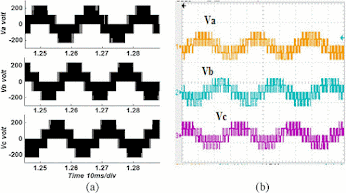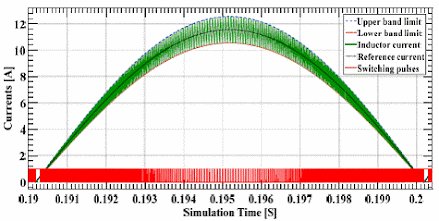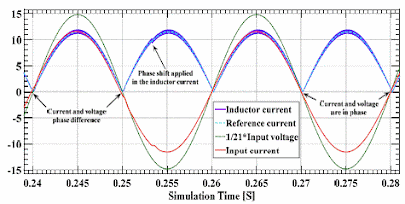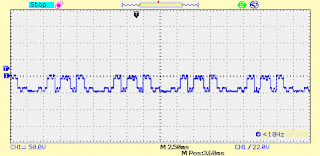ABSTRACT:
This paper presents an improvement technique for the
power quality of the electrical part of a wind generation system with a
self-excited induction generator (SEIG) which aims to optimize the utilization
of wind power injected into weak grids. To realize this goal, an uncontrolled
rectifier-digitally controlled inverter system is proposed. The advantage of
the proposed system is its simplicity due to fewer controlled switches which
leads to less control complexity. It also provides full control of active and
reactive power injected into the grid using a voltage source inverter (VSI) as
a dynamic volt ampere reactive (VAR) compensator. A voltage oriented control
(VOC) scheme is presented in order to control the energy to be injected into
the grid. In an attempt to minimize the harmonics in the inverter current and
voltage and to avoid poor power quality of the wind energy conversion system
(WECS), an filter is inserted between VOC VSI and the grid. The proposed technique
is implemented by a digital signal processor (DSP TMS320F240) to verify the
validity of the proposed model and show its practical superiority in renewable
energy applications.
KEYWORDS:
1.
Grid connected
systems
2.
Self-excited
induction generator (SEIG)
3.
Voltage
oriented control (VOC)
4.
Voltage source
inverter (VSI)
5.
Wind energy
conversion systems (WECSs)
SOFTWARE: MATLAB/SIMULINK
BLOCK DIAGRAM:
Fig.
1. Proposed SEIG-based WECS with VOC VSI.
EXPECTED SIMULATION
RESULTS:
Fig.
2. Line voltage of theVSI in frame (400 V/div–5ms). (a) Simulation. (b)
Experiment.
Fig.
3. Phase voltage of the VSI in frame (400 V/div–5 ms). (a) Simulation. (b)
Experiment.
Fig.
4. Grid phase voltage (50 V/div–10 ms) and injected current (1 A/div–10 ms).
(a) Simulation. (b) Experiment.
Fig.
5. Inverter phase voltage to be connected to the grid with only filter (50
V/div–10 ms). (a) Simulation. (b) Experiment.
Fig.
6. Harmonic spectrum of (a) injected current; (b) phase voltage
Fig.
7. Grid voltage (50 V/div–25 ms) and injected current (1 A/div–25 ms) under
step change in the reactive power injected into grid. (a) Simulation. (b)
Experiment.
Fig.
8. VSI response with filter for the grid and capacitor voltage (100 V/div–10
ms) with the injected line current (5 A/div–10 ms). (a) Simulation. (b)
Experiment.
Fig.
9. Harmonic spectrum analysis with filter. (a) Injected current harmonic content.
(b) Filter capacitor voltage harmonic content.
CONCLUSION:
In this paper, the SEIG-based WECS dynamic model has
been derived. The VOC grid connected VSI has been investigated for high
performance control operation. The test results showed how the control scheme
succeeded in injecting the wind power as active or reactive power in order to
compensate the weak grid power state. An filter is inserted between VOC VSI and
grid to obtain a clean voltage and current waveform with negligible harmonic
content and improve the power quality. Also, this technique achieved unity
power factor grid operation (average above 0.975), very fast transient response
within a fraction of a second (0.4 s) under different possible conditions (wind
speed variation and load variation), and high efficiency due to a reduced
number of components (average above 90%) has been achieved. Besides the
improvement in the converter efficiency, reduced mechanical and electrical
stresses in the generator are expected, which improves the overall system
performance. The experimental results obtained from a prototype rated at 250 W
showed that the current and voltage THD (2.67%, 0.12%), respectively, for the
proposed WECS with filter is less than 5% limit imposed by IEEE-519 standard.
All results obtained confirm the effectiveness of the proposed system feasible
for small-scale WECSs connected to weak grids.
REFERENCES:
[1]
V. Kumar, R. R. Joshi, and R. C. Bansal, “Optimal control of matrix-converter-based
WECS for performance enhancement and efficiency optimization,” IEEE Trans.
Energy Convers., vol. 24, no. 1, pp. 264–272, Mar. 2009.
[2]
Y. Zhou, P. Bauer, J. A. Ferreira, and J. Pierik, “Operation of grid connected
DFIG under unbalanced grid voltage,” IEEE Trans. Energy Convers., vol.
24, no. 1, pp. 240–246, Mar. 2009.
[3]
S. M. Dehghan, M.Mohamadian, and A. Y. Varjani, “A new variablespeed wind
energy conversion system using permanent-magnet synchronous generator and
z-source inverter,” IEEE Trans Energy Convers., vol. 24, no. 3, pp. 714–724,
Sep. 2009.
[4]
K. Tan and S. Islam, “Optimum control strategies for grid-connected wind energy
conversion system without mechanical sensors,” WSEAS Trans. Syst. Control,
vol. 3, no. 7, pp. 644–653, Jul. 2008, 1991-8763.
[5]
B. C. Rabelo, W. Hofmann, J. L. da Silva, R. G. de Oliveira, and S. R. Silva, “Reactive
power control design in doubly fed induction generators for wind turbines,” IEEE
Trans. Ind. Elect., vol. 56, no. 10, pp. 4154–4162, Oct. 2009.





































